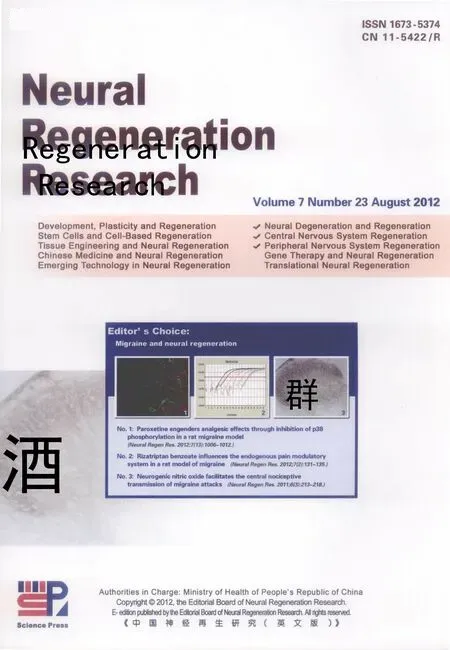Survey of spinal cord injury-induced neurogenic bladder studies using the Web of Science
Benjing Zou, Yongli Zhang, Yucheng Li, Zantao Wang, Ping Zhang, Xiyin Zhang, Bingdong Wang, Zhixin Long, Feng Wang, Guo Song, Yan Wang
1 Department of Urology, General Hospital of Liaohe Oil Field, Panjin 124010, Liaoning Province, China
2 Department of Radiology, General Hospital of Liaohe Oil Field, Panjin 124010, Liaoning Province, China
Survey of spinal cord injury-induced neurogenic bladder studies using the Web of Science
Benjing Zou1, Yongli Zhang1, Yucheng Li1, Zantao Wang1, Ping Zhang1, Xiyin Zhang1, Bingdong Wang1, Zhixin Long1, Feng Wang1, Guo Song1, Yan Wang2
1Department of Urology, General Hospital of Liaohe Oil Field, Panjin 124010, Liaoning Province, China
2Department of Radiology, General Hospital of Liaohe Oil Field, Panjin 124010, Liaoning Province, China
OBJECTIVE:To identify global trends in research on spinal cord injury-induced neurogenic bladder, through a bibliometric analysis using the Web of Science.
DATA RETRIEVAL:We performed a bibliometric analysis of studies on spinal cord injury-induced neurogenic bladder using the Web of Science. Data retrieval was performed using key words “spinal cord injury”, “spinal injury”, “neurogenic bladder”, “neuropathic bladder”, “neurogenic lower urinary tract dysfunction”, “neurogenic voiding dysfunction”, “neurogenic urination disorder” and“neurogenic vesicourethral dysfunction”.
SELECTION CRITERIA:Inclusion criteria: (a) published peer-reviewed articles on spinal cord injury-induced neurogenic bladder indexed in the Web of Science; (b) type of articles: original research articles and reviews; (c) year of publication: no limitation. Exclusion criteria: (a) articles that required manual searching or telephone access; (b) Corrected papers and book chapters.
MAIN OUTCOME MEASURES:(1) Annual publication output; (2) distribution according to journals; (3) distribution according to subject areas; (4) distribution according to country; (5) distribution according to institution; and (6) top cited publications.
RESULTS:There were 646 research articles addressing spinal cord injury-induced neurogenic bladder in the Web of Science. Research on spinal cord injury-induced neurogenic bladder was found in the Science Citation Index-Expanded as of 1946. The United States, Ireland and Switzerland were the three major countries contributing to studies in spinal cord injury-induced neurogenic bladder in the 1970s. However, in the 1990s, the United States, the United Kingdom, the Netherlands, Germany and Japan published more papers on spinal cord injury-induced neurogenic bladder than Switzerland, and Ireland fell off the top ten countries list. In this century, the United States ranks first in spinal cord injury-induced neurogenic bladder studies, followed by France, the United Kingdom, Germany, Switzerland and Japan. Subject categories including urology, nephrology and clinical neurology, as well as rehabilitation, are represented in spinal cord injury-induced neurogenic bladder studies.
CONCLUSION:From our analysis of the literature and research trends, we conclude that spinal cord injury-induced neurogenic bladder is a hot topic that will continue to generate considerable research interest in the future.
spinal cord injury; neurogenic bladder; neurogenic lower urinary tract dysfunction; neurogenic urination disorder; neurogenic vesicourethral dysfunction; urodynamics; Web of Science; neural regeneration
Research Highlights
(1) Neurogenic bladder after spinal cord injury is a hot topic.
(2) This study evaluated data from the Web of Science and used statistical analysis in Microsoft Excel. All articles referring to spinal cord injury-induced neurogenic bladder research in the Web of Science were assessed according to decade using the following criteria: document type, the number of author outputs, the output distribution in subject categories, the publication outputs ofcountries, the characteristics of outputs in journals, and the distribution of citations for each decade.
(3) We aimed to identify tendencies in spinal cord injury-induced neurogenic bladder research.
INTRODUCTION
To perform the bladder functions of urine storage and micturition, many organs and systems, including the cerebral cortex, pons, spinal cord and peripheral nervous system, are involved in the neural control of these processes[1]. If there is any damage to these organs, neurogenic bladder will occur[2-3]. Neurogenic bladder refers to dysfunction of the urinary bladder due to disease of the central nervous system or peripheral nerves involved in the control of urination.
Flow chart of micturition reflexes is shown below:

Neurogenic bladder and a series of complications might affect patients over their entire life, and are the main causes of death[4]. Accurate evaluation and reasonable treatment of neurogenic bladder are critical for reducing the occurrence of complications and allowing patients to enjoy nearly normal high-quality lives[5-6].
Spinal cord injury often leads to severe neurological dysfunction and disability, which not only affects the individual’s physiology and psychology, but also generates a heavy burden on families and society. Spinal cord injury can lead to neurogenic bladder that can cause renal failure, which is the first cause of death in advanced stage patients[7-8]. Therefore, it is of utmost importance to protect patients from the occurrence of urinary complications following spinal cord injury[9-10]. There is usually a correlation between the spinal cord segments injured and the functions of the bladder and urethra that are affected.
Although more progress has been made in reducing the incidence of renal failure than other serious complications of spinal cord injury, urinary tract complications continue to be a major cause of concern and morbidity[11]. Factors such as changes in bladder physiology, the often insidious nature of renal damage in spinal cord injury patients, and the adoption by patients of the bladder management most convenient for their physical and social needs all contribute to morbidity[12].
Our study is designed to find trends in spinal cord injury-induced neurogenic bladder research based on published research papers found in the Web of Science.
DATA SOURCES AND METHODOLOGY
Data retrieval
In this study, we used bibliometric methods to quantitatively and qualitatively investigate research trends in studies of spinal cord injury-induced neurogenic bladder. For this purpose, we employed the Web of Science, a research database of publications and citations that are selected and evaluated by the Institute for Scientific Information in Philadelphia, PA, USA, using the key words “spinal cord injury”, “spinal injury”,“neurogenic bladder”, “neuropathic bladder”, “neurogenic lower urinary tract dysfunction”, “neurogenic voiding dysfunction”, “neurogenic urination disorder” and“neurogenic vesicourethral dysfunction”. We did not limit the period of publication and searched 646 results, and downloaded the data on June 20, 2012.
Inclusion criteria
The inclusion criteria were as follows: (1) peer-reviewed articles on spinal cord injury-induced neurogenic bladder which were published and indexed in the Web of Science, including original research articles, reviews, meeting abstracts, proceedings papers, editorial material and letters; (2) the citation database was Science Citation Index-Expanded (SCI-E).
Exclusion criteria
We excluded articles that required manual searching or telephone access. We excluded a number of corrected papers from the total number of articles analyzed. The outcomes of all articles referring to spinal cord injury-induced neurogenic bladder were measured using the following criteria: (a) type of literature on spinal cord injury-induced neurogenic bladder; (b) annual publication output on spinal cord injury-induced neurogenic bladder; (c) journal publications on spinal cord injury-induced neurogenic bladder; (d) distribution by subject area in spinal cord injury-induced neurogenic bladder research; (e) publications on spinal cord injury-induced neurogenic bladder according to country; (f) publications on spinal cord injury-induced neurogenic bladder by institution.
RESULTS
Number of publications on spinal cord injury-induced neurogenic bladder between 1946 and 2012, according to decade (Figure 1)

Research on spinal cord injury-induced neurogenic bladder could be found in the SCI-E as of 1946, published in theCanadian Medical Association Journal, with the title “the neurogenic bladder in spinal cord injury”. There was no publication between January 1947 and the 1970s; eight documents could be searched in the 1970s. In the 1980s, there was only one publication, but the number was greatly increased in the 1990s, and reached a peak in the 2000s. There were only 10 articles before the 1990s, and therefore, here, we analyzed articles on spinal cord injury-induced neurogenic bladder studies in the 1990s and 2000s.
Analysis of publications on spinal cord injury-induced neurogenic bladder in the 1990s
The distribution of document types identified by the SCI-E was analyzed. Six document types were found among 160 publications between 1990 and 1999.
Articles (147) were the most frequent document type comprising 91.88% of all publications, followed by proceedings papers (10; 6.25%) and reviews (8; 5.00%). The remaining articles were editorials (2), notes (2) and a letter (1).
The annual publication output on spinal cord injury-induced neurogenic bladder in the 1990s is presented in Figure 2.

There were 160 publications on spinal cord injury-induced neurogenic bladder in the Web of Science between 1990 and 1999. The number of publications, per year, on spinal cord injury-induced neurogenic bladder increased over this 10-year period. In total, 30 papers were published and included in the Web of Science in 1999, which was much more than in 1990.
The top 11 journals that published papers on spinal cord injury-induced neurogenic bladder between 1990 and 1999 are presented in Table 1.

Table 1 Top 11 journals that published studies on spinal cord injury-induced neurogenic bladder included in theWeb of Science between 1990 and 1999
In Table 1, it is evident that most papers on spinal cord injury-induced neurogenic bladder appeared in journals with a particular focus on urology or the spinal cord.The Journal of Urologypublished 29 papers which accounted for 18.13% of the total number of publications, followed bySpinal Cordwhich published 26 papers and accounted for 16.25% of publications.
Based on the classification of subject categories inJournal Citation Reports2010, the article output data were grouped into 250 subject categories. The articles of the top six most productive subject categories related to spinal cord injury-induced neurogenic bladder between 1990 and 1999 are presented in Table 2.

Table 2 Distribution of subject areas related to spinal cord injury-induced neurogenic bladder included in the Web of Science between 1990 and 1999
In Table 2, it is evident that among the subject categories related to spinal cord injury-induced neurogenic bladder, the greatest number of studies (80 papers) was in the field of urology and nephrology, which accounted for 50.00% of publications. With 53 papers, the second highest number of studies was in the field of clinical neurology, which accounted for 33.13% of publications.
The distribution of publications, by country, on spinal cord injury-induced neurogenic bladder between 1990 and 1999 is presented in Table 3. Thomas Jefferson University (7; 4.38%). Radboud University Nijmegen and the University of Texas were ranked fourth with four papers each.
The most cited publications in spinal cord injury-induced neurogenic bladder research in the Web of Science between 1990 and 1999 are presented in Table 4.
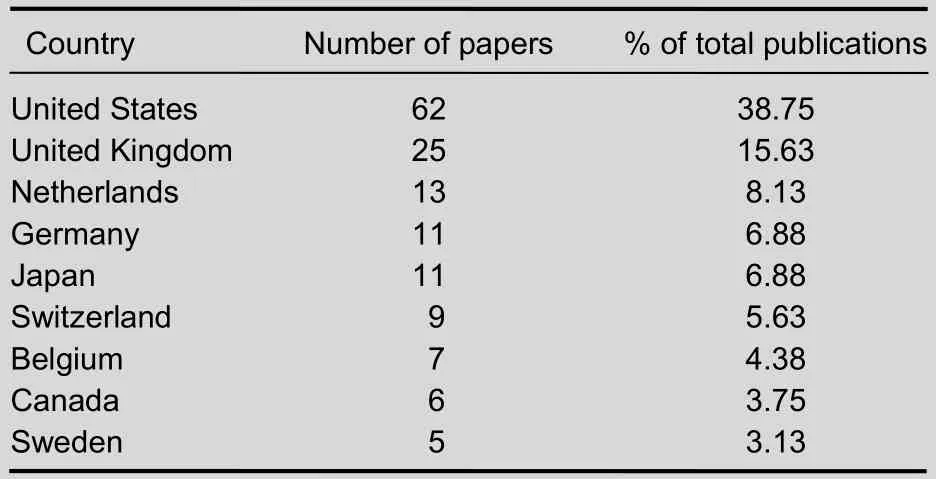
Table 3 Top nine countries publishing studies on spinal cord injury-induced neurogenic bladder included in the Web of Science between 1990 and 1999
In Table 3, it is clear that the United States published the highest number of papers on spinal cord injury-induced neurogenic bladder. The United States published 62 papers which accounted for 38.75% of the total; this is much higher than the number of papers published by other countries. The United Kingdom ranked second with 25 papers and accounted for 15.63% of the total. It is surprising that there were no papers from Mainland China, apart from the three papers published by researchers in Taiwan, China.
The top five institutions for studies on spinal cord injury-induced neurogenic bladder included in the Web of Science in the 1990s are the following: University of Pittsburgh, ranked first with 10 papers, accounting for 6.25% of the total number of publications, followed by Eastbourne District General Hospital (8; 5.00%) and

Table 4 Top ten cited publications on spinal cord injury-induced neurogenic bladder in the Web of Science between 1990 and 1999
Analysis of publications in spinal cord injury-induced neurogenic bladder in the 2000s
The different types of publications relating to spinal cord injury-induced neurogenic bladder in the 2000s are presented in Table 5.
Table 5 Types of publications on spinal cord injury-induced neurogenic bladder included in the Web of Science between 2000 and 2010

Type of literature Number of papers % of total publications Article 302 83.89 Review 46 12.78 Proceedings paper 43 11.94 Meeting abstract 7 1.94 Editorial material 3 0.83 Letter 2 0.56 Book chapter 1 0.28
In Table 5, it is found that articles, reviews and proceedings papers constituted the major types of publications related to spinal cord injury-induced neurogenic bladder over this period. There were 302 articles, accounting for 83.89% of the total number of publications, which was more than any other type of literature, followed by reviews (46) and proceedings papers (43).
The annual publication output on spinal cord injury-induced neurogenic bladder in the 2000s is presented in Figure 3.

Distribution of output per subject category is presented in Table 6.
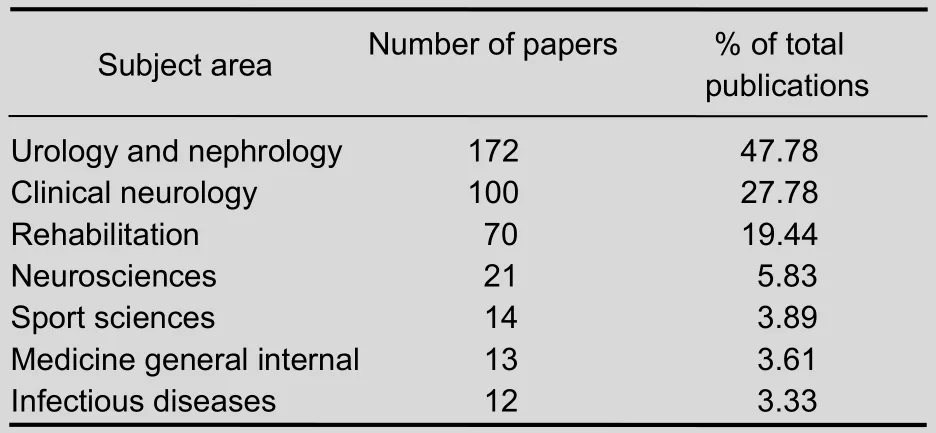
Table 6 Distribution of output for the various subject areas related to spinal cord injury-induced neurogenic bladder in the Web of Science between 2000 and 2009
We found that the number of scientific articles per category exhibited constant growth during this period, which indicates that spinal cord injury-induced neurogenic bladder research has been developing steadily in the various categories.
The contribution of different countries to the publications was based on journal articles in which the address and affiliation of at least one author were provided. The top nine countries in the 2000s are listed in Table 7.
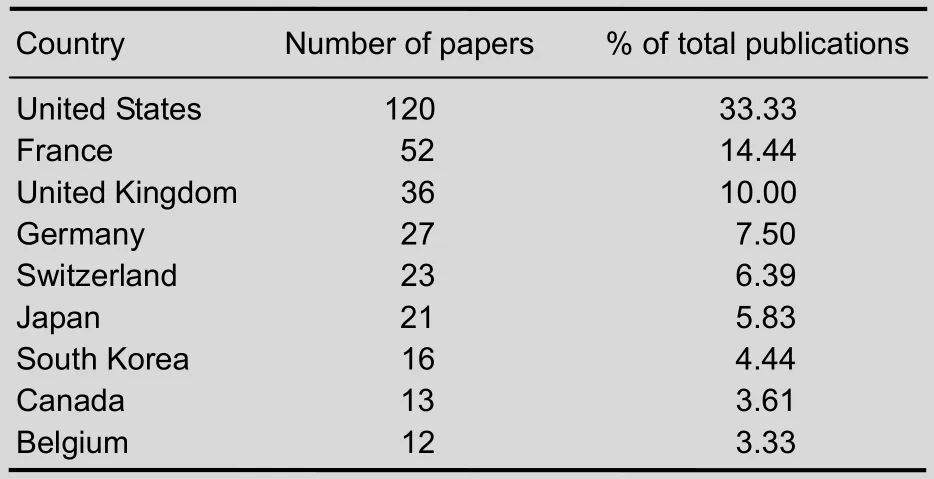
Table 7 Top nine countries in terms of number of studies on spinal cord injury-induced neurogenic bladder included in the Web of Science from 2000 to 2009
The United States, France and the United Kingdom were the three most productive countries, and the United States had the highest publication numbers for the decade with 120 papers, accounting for 33.33% of the total.
The top five institutions for studies on spinal cord injury-induced neurogenic bladder included in the Web of Science in 2000s are as follows: University of Paris 6, ranked first with 27 papers, accounting for 7.50% of publications, followed by University of Pittsburgh (22; 6.11%) and Université Claude Bernard Lyon 1 (15; 4.17%). Eastbourne District General Hospital and University of Medicine and Dentistry of New Jersey ranked fourth with 10 papers each.
China can take pride that there are nine papers published by Chinese authors. These are the following:An artificial somatic-central nervous system-autonomic reflex pathway for controllable micturition after spinal cord injury: preliminary results in 15 patients, written by Xiaoet al[23].
An artificial somatic-autonomic reflex pathway procedure for bladder control in children with spina bifida, written by Xiaoet al[24].
Reinnervation for neurogenic bladder: historic review and introduction of a somatic-autonomic reflex pathway procedure for patients with spinal cord injury or spina bifida, written by Xiao CG[25].
灾害对宏观经济的影响是一个非常复杂的过程,其核心问题是研究灾害对区域经济发展的影响有多大,这种影响是正面的还是负面的,目前尚没有达到一致性的结论.关于这方面的研究大体可以分为两类:第一类是研究灾害对经济的短期影响,即研究灾后1~5 a内灾害对经济发展的影响[57,59];第二类是研究灾害对经济的长期影响,即灾害发生5 a以后对经济发展的影响[37,71].GDP是衡量区域经济发展的核心指标,因此,相关的研究中多以GDP或GDP增长率作为灾害影响的因变量来进行分析.
Clinical study of reconstructed bladder innervation below the level of spinal cord injury to produce urination by Achilles tendon-to-bladder reflex contractions, written by Linet al[26].
Expressions of voltage-gated K+channel 2.1 and 2.2 in rat bladder with detrusor hyperreflexia, written by Ganet al[27].
Reconstructed bladder innervation below the level of spinal cord injury: the knee-tendon to bladder artificial reflex arc, written by Zhenget al[28].
Reconstruction of reflex pathways to the atonic bladder after conus medullaris injury: preliminary clinical results, written by Linet al[29].
Urodynamic study in the neurogenic bladder dysfunction caused by intervertebral disk hernia, written by Donget al[30].
The assessment of bladder and urethral function in spinal cord injury patients, written by Chenet al[31].
The top eight journals that published papers on spinal cord injury-induced neurogenic bladder between 2000 and 2009 are presented in Table 8.
Table 8 Top eight journals that published studies on spinal cord injury-induced neurogenic bladder included in the Web of Science between 2000 and 2009
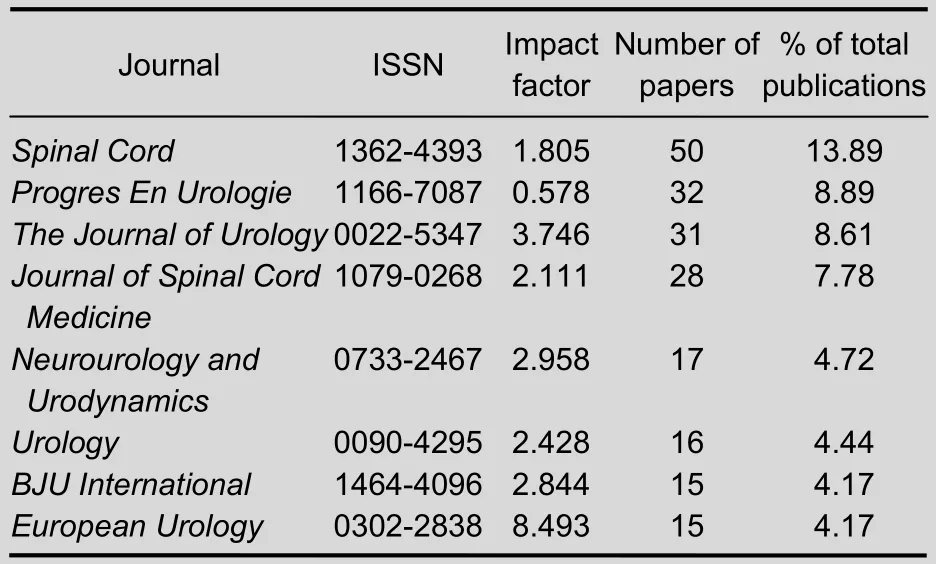
Journal ISSN Impact factor Number of papers % of total publications Spinal Cord 1362-4393 1.805 50 13.89 Progres En Urologie 1166-7087 0.578 32 8.89 The Journal of Urology 0022-5347 3.746 31 8.61 Journal of Spinal Cord Medicine 1079-0268 2.111 28 7.78 Neurourology and Urodynamics 0733-2467 2.958 17 4.72 Urology 0090-4295 2.428 16 4.44 BJU International 1464-4096 2.844 15 4.17 European Urology 0302-2838 8.493 15 4.17
In Table 8, it is found thatSpinal Cordpublished 50 papers which accounted for 13.89% of the total number of publications, followed byProgres En UrologieandThe Journal of Urologywhich published 32 and 31 papers respectively.
According to bibliometric principles, the main index for evaluating the quality of an article is the amount of citations it garners. According to scientometrics, a reference is considered a “classical reference” when the article has been cited four or more times[32]. The top 13 citations based on our analysis in the 2000s are listed in Table 9, these are all classical references in the spinal cord injury-induced neurogenic bladder field.
DISCUSSION
In 1994, the International Medical Society of Paraplegia recommended the adoption of the neurological classification system for spinal cord injury prepared by the American Spinal Injury Association as the international classification standard, which was modified in 2000[46].
The Bors-Comarr classification system is primarily applied for voiding dysfunction at the end of the spinal shock phase of spinal cord injury.
Based on the anatomy of lesions, nerve injuries are divided into UMN and LMN; the former refers to spinal cord injury above the sacral level, while the latter refers to sacral dorsal or sacral nerve root injury. Moreover, according to the classification system, the diseases are divided into complete and incomplete injuries in accordance with the severity of nerve injury; according to RU, they are also divided into “balanced” or“non-balanced” lower urinary tract function. This classification system, to a certain extent, reflects the function of the bladder and urethra.

Table 9 Top 13 cited publications on spinal cord injury-induced neurogenic bladder in the Web of Science between 2000 and 2009
Based on the bibliometric analysis, the following comparisons and results were obtained for spinal cord injury-induced neurogenic bladder:
First, there are 646 research articles addressing spinal cord injury-induced neurogenic bladder included in the Web of Science. Research on spinal cord injury-induced neurogenic bladder could be found in the SCI-E as of 1946, in an article published in theCanadian Medical Association Journalwith the title “the neurogenic bladder in spinal cord injury”. There were no publications between January 1947 and the 1970s; eight documents could be searched. In the 1980s, there was only one publication. Research on spinal cord injury-induced neurogenic bladder has attracted ever-increasing attention among global researchers from the 2000s, notwithstanding slight drops in output in the 2010s.
Second, the United States, Ireland and Switzerland were the three primary countries that studied spinal cord injury-induced neurogenic bladder in the 1970s.
The United States was the most prominent, publishing seven papers. Rancho Los Amigos Hospital,
University of Minnesota, University of Southern California and Veterans ADM Hospital were the main institutions publishing studies on spinal cord injury-induced neurogenic bladder. However, in the 1990s, the United States, the United Kingdom, the Netherlands, Germany and Japan published more papers on spinal cord injury-induced neurogenic bladder research than Switzerland, and Ireland fell off the top ten list. Ten papers were from the University of Pittsburgh, followed by Eastbourne District General Hospital and Thomas Jefferson University. In the 2000s, the United States still ranked first in spinal cord injury-induced neurogenic bladder research, followed by France, the United Kingdom, Germany, Switzerland and Japan. Subject categories including urology, nephrology and clinical neurology, as well as rehabilitation, were represented in spinal cord injury-induced neurogenic bladder studies.
Third, journals focusing on neuroscience published the most articles on spinal cord injury-induced neurogenic bladder.The Journal of Urology,Spinal Cord, andParaplegiahad the top three highest total number of publications in the 1990s. In the 2000s,Spinal Cordranked first, followed byProgres En UrologieandThe Journal of Urology. The most cited paper is not necessarily the highest impact paper on an annual basis. The immediate impact during the year when the article is published is indicated by the average number of citations per annum.
The findings of the present study may be of interest to researchers who are currently undertaking studies in this field, as well as those planning future studies on spinal cord injury-induced neurogenic bladder.
Author contributions: Benjing Zou designed the study. Yongli Zhang and Yucheng Li retrieved the references and extracted the data. Zantao Wang, Ping Zhang and Xiyin Zhang wrote the manuscript. Bingdong Wang, Zhixin Long, Feng Wang, Guo Song retrieved the references, extracted the data, and provided technical support and statistical calculations. Yan Wang revised the manuscript.
Conflicts of interest:None declared.
[1] de Groat WC. Central neural control of the lower urinary tract. Ciba Found Symp. 1990;151:27-44.
[2] Dijkema HE, Weil EH, Mijs PT, et al. Neuromodulation of sacral nerves for incontinence and voiding dysfunctions. Clinical results and complications. Eur Urol. 1993;24(1):72-76.
[3] McGuire E, Morrissey S, Zhang S, et al. Control of reflex detrusor activity in normal and spinal injured non-human primates. J Urol. 1983;129(1):197-199.
[4] Hao DJ, He LM, Yuan FY. Late complications in patients with spinal cord injury and related factors. Zhongguo Jizhu Jisui Zazhi. 2005;15(5):267-270.
[5] Ku JH. The management of neurogenic bladder and quality of life in spinal cord injury. BJU Int. 2006;98(4):739-745.
[6] Stöhrer M, Castro-Diaz D, Chartier-Kastler E, et al. Guidelines on neurogenic lower urinary tract dysfunction. Prog Urol. 2007;17(3):703-755.
[7] Zhang XJ, Qian SQ, Meng QX, et al. Complication and prevention situation of neurogenic baldder after spinal cord injury. Shiyong Yiyao Zazhi. 2008;25(4):480-483.
[8] Fonte N. Urological care of the spinal cord-injured patient. J Wound Ostomy Continence Nurs. 2008;35(3):323-331.
[9] Chen Z. Rehabilitation therapy of neurogenic lower urinary tract dysfunction. Zhonghua Wuli Yixue yu Kangfu Yixue Zazhi. 2008;30(3):213-215.
[10] Middleton JW, Leong G, Mann L. Management of spinal cord injury in general practice. Aust Fam Physician. 2008;37(4):229-233.
[11] Stover SL, Lloyd KL, Waites KB, et al. Urinary tract infection in spinal cord injury. Arch Phys Med Rehabil. 1989;70:47-54.
[12] Lloyd LK. Long-term follow-up of neurogenic bladder. Phys Med Rehab Clin N Am. 1993;4:391-409.
[13] de Groat WC. A neurologic basis for the overactive bladder. Urology. 1997;50(6A Suppl):36-52.
[14] Westgren N, Levi R. Quality of life and traumatic spinal cord injury. Arch Phys Med Rehabil. 1998;79(11):1433-1439.
[15] Karlsson AK. Autonomic dysreflexia. Spinal Cord. 1999; 37(6):383-391.
[16] Cardenas DD, Hooton TM. Urinary tract infection in persons with spinal cord injury. Arch Phys Med Rehabil. 1995;76(3):272-280.
[17] Wein AJ. Pharmacologic options for the overactive bladder. Urology. 1998;51(2A Suppl):43-47.
[18] Egon G, Barat M, Colombel P, et al. Implantation of anterior sacral root stimulators combined with posterior sacral rhizotomy in spinal injury patients. World J Urol. 1998;16(5):342-349.
[19] Van Kerrebroeck PE, Koldewijn EL, Rosier PF, et al. Results of the treatment of neurogenic bladder dysfunction in spinal cord injury by sacral posterior root rhizotomy and anterior sacral root stimulation. J Urol. 1996;155(4):1378-1381.
[20] Rijkhoff NJ, Wijkstra H, van Kerrebroeck PE, et al. Urinary bladder control by electrical stimulation: review of electrical stimulation techniques in spinal cord injury. Neurourol Urodyn. 1997;16(1):39-53.
[21] Gerridzen RG, Thijssen AM, Dehoux E. Risk factors for upper tract deterioration in chronic spinal cord injury patients. J Urol. 1992;147(2):416-418.
[22] Yoshiyama M, Nezu FM, Yokoyama O, et al. Changes in micturition after spinal cord injury in conscious rats. Urology. 1999;54(5):929-933.
[23] Xiao CG, Du MX, Dai C, et al. An artificial somatic-central nervous system-autonomic reflex pathway for controllable micturition after spinal cord injury: preliminary results in 15 patients. J Urol. 2003;170(4 Pt 1):1237-1241.
[24] Xiao CG, Du MX, Li B, et al. An artificial somaticautonomic reflex pathway procedure for bladder control in children with spina bifida. J Urol. 2005;173(6):2112-2116. [25] Xiao CG. Reinnervation for neurogenic bladder: historic review and introduction of a somatic-autonomic reflex pathway procedure for patients with spinal cord injury or spina bifida. Eur Urol. 2006;49(1):22-28.
[26] Lin H, Hou C, Zhen X, et al. Clinical study of reconstructed bladder innervation below the level of spinal cord injury to produce urination by Achilles tendon-to-bladder reflex contractions. J Neurosurg Spine. 2009;10(5):452-457.
[27] Gan XG, An RH, Bai YF, et al. Expressions of voltage-gated K+ channel 2.1 and 2.2 in rat bladder with detrusor hyperreflexia. Chin Med J (Engl). 2008;121(16):1574-1577.
[28] Zheng XY, Hou CL, Zhong HB, et al. Reconstructed bladder innervation below the level of spinal cord injury:the knee-tendon to bladder artificial reflex arc. J Spinal Cord Med. 2009;32(1):79-85.
[29] Lin H, Hou CL, Zhong G, et al. Reconstruction of reflex pathways to the atonic bladder after conus medullaris injury: preliminary clinical results. Microsurgery. 2008; 28(6):429-435.
[30] Dong D, Xu Z, Shi B, et al. Urodynamic study in the neurogenic bladder dysfunction caused by intervertebral disk hernia. Neurourol Urodyn. 2006;25(5):446-450.
[31] Chen Z, Sun S, Deng R, et al. The assessment of bladder and urethral function in spinal cord injury patients. J Huazhong Univ Sci Technolog Med Sci. 2009;29(5):609-613.
[32] Zhou JY, Sun T.A Quantitative analysis of digital library research article based on the Web of Science.Qingbao Kexue. 2005;23(10):1521-1525.
[33] Anderson KD. Targeting recovery: priorities of the spinal cord-injured population. J Neurotrauma. 2004;21(10):1371-1383.
[34] Reitz A, Stöhrer M, Kramer G, et al. European experience of 200 cases treated with botulinum-A toxin injections into the detrusor muscle for urinary incontinence due to neurogenic detrusor overactivity. Eur Urol. 2004;45(4):510-515.
[35] Peckham PH, Knutson JS. Functional electrical stimulation for neuromuscular applications. Annu Rev Biomed Eng. 2005;7:327-360.
[36] Sheffler LR, Chae J. Neuromuscular electrical stimulation in neurorehabilitation. Muscle Nerve. 2007;35(5):562-590.
[37] Stöhrer M, Blok B, Castro-Diaz D, et al. EAU guidelines on neurogenic lower urinary tract dysfunction. Eur Urol. 2009; 56(1):81-88.
[38] Compérat E, Reitz A, Delcourt A, et al. Histologic features in the urinary bladder wall affected from neurogenic overactivity--a comparison of inflammation, oedema and fibrosis with and without injection of botulinum toxin type A. Eur Urol. 2006;50(5):1058-1064.
[39] Cheng CL, de Groat WC. The role of capsaicin-sensitive afferent fibers in the lower urinary tract dysfunction induced by chronic spinal cord injury in rats. Exp Neurol. 2004;187(2):445-454.
[40] Amend B, Hennenlotter J, Schäfer T, et al. Effective treatment of neurogenic detrusor dysfunction by combined high-dosed antimuscarinics without increased side-effects. Eur Urol. 2008;53(5):1021-1028.
[41] Ehren I, Volz D, Farrelly E, et al. Efficacy and impact of botulinum toxin A on quality of life in patients with neurogenic detrusor overactivity: a randomised, placebo-controlled, double-blind study. Scand J Urol Nephrol. 2007;41(4):335-340.
[42] Tai C, Wang J, Wang X, et al. Bladder inhibition or voiding induced by pudendal nerve stimulation in chronic spinal cord injured cats. Neurourol Urodyn. 2007;26(4):570-577.
[43] Akbar M, Abel R, Seyler TM, et al. Repeated botulinum-A toxin injections in the treatment of myelodysplastic children and patients with spinal cord injuries with neurogenic bladder dysfunction. BJU Int. 2007;100(3):639-645.
[44] Pontari MA, Braverman AS, Ruggieri MR Sr. The M2 muscarinic receptor mediates in vitro bladder contractions from patients with neurogenic bladder dysfunction. Am J Physiol Regul Integr Comp Physiol. 2004;286(5):R874-R880.
[45] Chancellor MB, Chartier-Kastler EJ. Principles of sacral nerve stimulation (SNS) for the treatment of bladder and urethral sphincter dysfunctions. Neuromodulation. 2000; 3(1):16-26.
[46] Moslavac S, Dzidic I, Kejla Z. Neurogenic detrusor overactivity: comparison between complete and incomplete spinal cord injury patients. Neurourol Urodyn. 2008;27(6):504-506.
Cite this article as:Neural Regen Res. 2012;7(23):1832-1839.
Benjing Zou, Chief physician, Master’s supervisor, Department of Urology, General Hospital of Liaohe Oil Field, Panjin 124010, Liaoning Province, China
Benjing Zou, Department of Urology, General Hospital of Liaohe Oil Field, Panjin 124010, Liaoning Province, China
zoubenjing@medmail.com. cn
2012-04-14
2012-07-02
(N20120806006/ZLJ)
Zou BJ, Zhang YL, Li YC, Wang ZT, Zhang P, Zhang XY, Wang BD, Long ZX, Wang F, Song G, Wang Y.
Survey of spinal cord injury-induced neurogenic bladder studies using the Web of Science. Neural
Regen Res. 2012;7(23):1832-1839.
www.crter.cn
www.nrronline.org
10.3969/j.issn.1673-5374. 2012.23.010
(Edited by ZLJ/Song LP)
- 中国神经再生研究(英文版)的其它文章
- Current therapeutic strategies for inflammation following traumatic spinal cord injury☆●
- Stem cell therapy in neurodegenerative diseases From principles to practice●
- Meta-analysis of efficacy of topiramate in migraine prophylaxis★
- Differentiation of endogenous neural stem cells in adult versus neonatal rats after brachial plexus root avulsion injury*☆
- An enriched environment improves cognitive performance in mice from the senescenceaccelerated prone mouse 8 strain Role of upregulated neurotrophic factor expression in the hippocampus***☆
- Human amnion tissue injected with human umbilical cord mesenchymal stem cells repairs damaged sciatic nerves in rats*★

